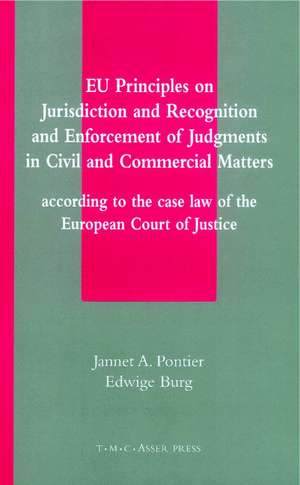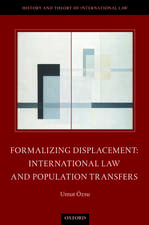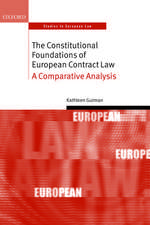EU Principles on Jurisdiction and Recognition and Enforcement of Judgments in Civil and Commercial Matters: According to the Case Law of the European Court of Justice
Autor Jannet A. Pontier, Edwige Burgen Limba Engleză Hardback – 12 aug 2004
The present study is based on an analysis of more than one hundred decisions that the Court has delivered under the Brussels Convention. It appears that the significance of the Court’s case law lies not only in the final outcome of these decisions, but also in the principles that the Courtconsistently refers to in arriving at its decisions.
The authors piece together the system of principles that has become apparent in the Court’s reasoning. An understanding of this system not only sheds light on how and why the Court has reached its past decisions, but it also enables lawyers to understand the confines within which the Court’s argumentation is likely to take place in future cases under the Regulation.
A publication which focuses on the principles used by the Court to justify its decisions in this particular area of law, has been lacking. This book aims to fill that gap. Its value extends beyond the academic realm and into the field of legal practice.
Preț: 395.09 lei
Nou
Puncte Express: 593
Preț estimativ în valută:
75.60€ • 78.93$ • 62.57£
75.60€ • 78.93$ • 62.57£
Carte tipărită la comandă
Livrare economică 04-18 aprilie
Preluare comenzi: 021 569.72.76
Specificații
ISBN-13: 9789067041737
ISBN-10: 9067041734
Pagini: 269
Ilustrații: 278 p.
Greutate: 0.58 kg
Ediția:1st Edition.
Editura: T.M.C. Asser Press
Colecția T.M.C. Asser Press
Locul publicării:The Hague, Germany
ISBN-10: 9067041734
Pagini: 269
Ilustrații: 278 p.
Greutate: 0.58 kg
Ediția:1st Edition.
Editura: T.M.C. Asser Press
Colecția T.M.C. Asser Press
Locul publicării:The Hague, Germany
Public țintă
Professional/practitionerCuprins
Preface; Introduction; 1. The method of interpretation used by the court of justice: the model of principles; Introduction; 1.1. Reasoning according to the model of principles; 1.2. The model of principles and judicial constraints; 1.3. The problem of conflicting principles; Concluding remarks; 2. A bird's-eye view of the system of principles; Introduction; 2.1. The four main principles and their relation to the most general principle underlying the convention; 2.2. The significance of the most general principle of 'strengthening the legal protection of persons established in the community'; Conclusions and outlook; 3. The first main principle: free movement of judgements; Introduction; 3.1. The principle of full respect for another contracting state's judgements; 3. 2. The principle of a swift and simple procedure for the recognition and enforcement of another contracting state's judgements; conclusions and summary; 4. The second main principle: the protection of the rights of the defence; Introduction; 4.1. The defendant's right to a proper service of the document instituting the proceedings; 4.2. The defendant's right to be heard in an appropriate court; 4.3. The defendant's right to an inter partes hearing; 4.4. The right to be defended by a lawyer; 4.5. The right to submit a defence on the substance of the case; 4.6. The defendant's interest in staying the execution proceedings when an appeal has been or will be lodged in the state of origin; 4.7. The defendant's right to be properly served with a decision delivered in a Contracting State; Conclusions and summary; 5. The third main principle: legal certainty; Introduction; 5.1. Equality and uniformity of rights and obligations arising from the convention; 5.1.1 Autonomous interpretation of concepts used in the Convention; 5.1.2 The convention prevails over national provisions that are incompatible with it; 5.2. Respect for the wording of the convention's provisions; 5.3. Legal certainty with regard to the scopeof the convention; 5.4. Legal certainty with regard to the allocation of jurisdiction; 5.4.1 Clarity as to the rules of jurisdiction; 5.4.2 Avoiding (further) multiplication of jurisdiction as regards one and the same legal relationship; 5.4.3 National courts should be able readily to decide whether they are competent to hear a case; 5.5. Legal certainty as to judgements: avoiding irreconcilable decisions; Conclusions and summary; 6. The fourth main principle: disputes should be decided by an appropriate court; Introduction; 6.1. The principle of the protection of the weaker party; Introduction; 6.1.1 The principle of the protection of the party who is weaker due to his procedural position; 6.1.2 The principle of the protection of the party who is weaker due to his socio-economic position; 6.1.3 The principle of the protection of the party that might be unaware of a jurisdiction clause incorporated in a contract by the other party; Conclusions and summary; 6.2. The principle of party autonomy; Introduction; 6.2.1 Prorogation by explicit agreement; 6.2.2 Prorogation by appearance; 6.2.3 Jurisdiction clauses versus agreements concerning the place of performance; Conclusions and summary; 6.3. The principle of a sound administration of justice; Introduction; 6.3.1 The principle that a court that has the practical advantage of first-hand knowledge of the facts, ease of taking evidence and/or knowledge of the applicable law should decide a case; 6.3.2 The principle that an entire dispute should be decided by a single court; Conclusions and summary; 6.4. The overall ideal that an entire dispute should be heard by a single and appropriate court; Introduction; 6.4.1 A party must not be deprived of or removed from the courts that would otherwise be competent, for no good reason; 6.4.2 Mitigating the disadvantages of having different courts ruling on different aspects of the same dispute; 6.4.3 Th


















